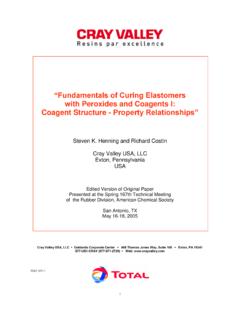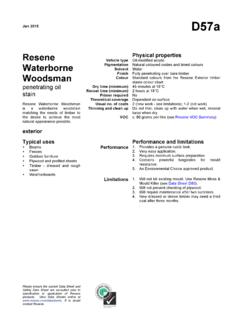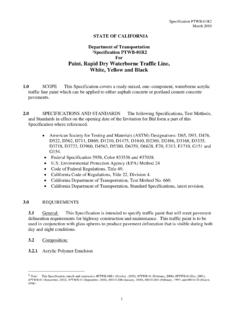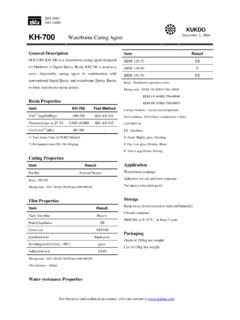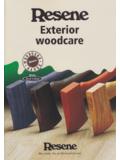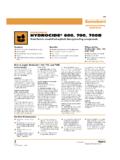Transcription of A New pH Neutral Waterborne Dispersing Resin For …
1 APPLICATION BULLETIN. A New pH Neutral Waterborne The challenge to select the proper Dispersing Resin Dispersing Resin For Metallic And becomes even more difficult when the pigment, itself, can react or deteriorate from this interaction. Organic Pigments Such is the case with metallic pigments, which present special issues for the preparation of stable Abstract water-based dispersions and inks. A new styrene-maleic anhydride-based Dispersing Resin is described and its utility in preparing water- Metallic pigments are finally divided powders or based metallic and organic pigment dispersions and platelets of a metal or a metal alloy.
2 While metallic printing inks is demonstrated. This Resin contains pigments have a unique appearance combining color amic acid functionality, groups that are possible to and brilliance, they also have a unique reactivity form only with anhydride-containing resins. A unique compared to typical organic pigments. Compared combination of properties is exhibited by this Resin , to organic compounds, metals have a low reduction including Neutral pH, high water solubility, low potential. The consequence of this is that in an molecular weight and high acid number. The amic oxidizing environment, the oxidant will be reduced acid Resin functions as an efficient polymeric and the metal will be oxidized in a so called redox surfactant in a range of water-based Dispersing and couple reaction.
3 Emulsifying applications. For example, it can be used to prepare high solids, low viscosity dispersions of The redox chemistries of the metals and alloys organic pigments. In addition, the Dispersing Resin typically used in graphic arts are well For can be combined with a co- Resin or an emulsified example, copper, which, either by itself or as its wax to produce a vehicle to disperse metallic alloy with zinc, is the predominant metal in gold . pigments. Typical formulations and their properties inks, has a reduction potential of : are described in this paper. Cu Cu+2 + 2 e- gE = - V. Background Dispersing resins are a crucial ingredient to water- (For comparison, actual gold has a reduction based ink formulations.)
4 Functions carried out by potential of , which is why it is a much more Dispersing resins include wetting the pigment stable, noble metal.) The low reduction potential surfaces, facilitating the breakup of pigment for copper causes it to react even under relatively agglomerates to maximize color development, mild, ambient conditions. A shiny, new copper stabilizing the dispersion of pigment particles and surface will rapidly acquire a tarnished patina due modifying the rheological properties of the to reaction with atmospheric oxygen and carbon dispersion and finished ink formulations. In addition dioxide to form a coating of copper carbonate: to carrying out these functions, the Dispersing Resin must be compatible with the myriad of other 2 Cu + H2O + CO2 + O2 Cu2 (OH)2 CO3.
5 Ingredients that are used in preparing dispersions and inks. Defoamers, surfactants and emulsion In water solution, copper will react with trace solutions all are, or contain, surface active molecules hydroxide to form copper hydroxide, Cu(OH2). In that can potentially interact with the Dispersing Resin . the presence of ammonia, this solid reacts to form a bright blue complex: Oaklands Corporate Center, 468 Thomas Jones Way, Suite 100, Exton, PA 19341. Toll Free 877-871-2729. 4950 01/10. Cu(OH)2 + 4 NH3 (aq) [Cu(NH3)4]+2 (aq) + 2OH- (aq) elements with the existing anionic functionality. Alternatively, co-solvents, such as alcohols or These are but several examples of the many glycols, can be added to increase the water solubility reactions that can deteriorate metallic pigments, of the partially neutralized Resin .
6 This approach, causing them to lose their true color and brilliance. however, introduces VOC into the formulation, contrary to the purpose of having a water-based The rate at which metals corrode or tarnish is highly formulation. In addition, both strategies merely dilute dependent upon their surrounding environment. An the ammonium hydroxide functionality rather than environment containing finely divided, high surface eliminate it. area metal particles in an aqueous media with ionic additives is clearly not conducive to long term Water-based dispersion and emulsion resins stability. Therefore, the challenge for any new typically have high molecular weight and low acid metallic pigment Dispersing Resin is to provide the number.
7 They consist of agglomerates of high needed wetting and rheological properties while molecular weight acrylic or acrylic-styrene Resin maintaining or enhancing the stability and stabilized by a solution Resin . Due to their high appearance of the metal surfaces. molecular weight, these resins have poorer wetting properties, and often must be used in combination Current Water Soluble, pH Neutral Resins with a low molecular weight surfactant package. A variety of different water soluble resins are Also, since the same type of solution Resin that is currently used to prepare metallic pigment used to make pigment dispersions is often used to dispersions and inks.
8 While, as a group, these resins stabilize the emulsion latex, in a sense, use of these offer a spectrum of performance vs. cost resins in metallic formulations again introduces possibilities, these limited choices do not provide a ammonium hydroxide functionality in a dilute form. universal solution to issues encountered when formulating. Several water-soluble resins based upon new functional chemistry have been introduced recently. Solution Dispersing resins are most commonly low For example2, sulfopolyester and sulfopolyester molecular weight copolymers of acrylic acid. They hybrid resins are soluble in water due to the presence have high acid numbers and are solubilized in water of diethylene glycol and, especially, 5-sulfo- by neutralizing their carboxylic acid groups, most isophthalic acid monomer units.
9 The sulfonic acid commonly with ammonium hydroxide. They form groups have different pKas and different surfactant true solutions, with limited self-agglomeration, a very properties compared to carboxylic acid functional small particle size and a clear appearance. These groups, and consequently the resins exhibit an solutions have very good wetting properties, and interesting combination of properties. However, are a common ingredient in many organic pigment these resins are relatively expensive compared to dispersions. However, the ammonium hydroxide acrylic based solution resins. carboxylic salt functionality which provides the water solubility contributes to poor stability with metallic While there are a number of water soluble resins pigments.
10 That are currently used in preparing metallic pigments and inks, there are still needs for new resins that Different approaches have been used to reduce the combine unique combinations of properties using concentration of carboxylate salt functional groups cost efficient building blocks. while maintaining the solution Resin 's water solubility. These include partially esterifying the acid groups Styrene-Maleic Anhydride Resins: Platforms with an alcohol which has hydrophilic For Polymeric Surfactants characteristics, such as an ethylene oxide oligomer. Styrene-maleic anhydride copolymers (SMA . However, this can modify the surfactant properties Resins) have a long history of use in the graphic of the resins, as is introduces non-ionic surfactant arts industry as Dispersing resins and additives in 2.









